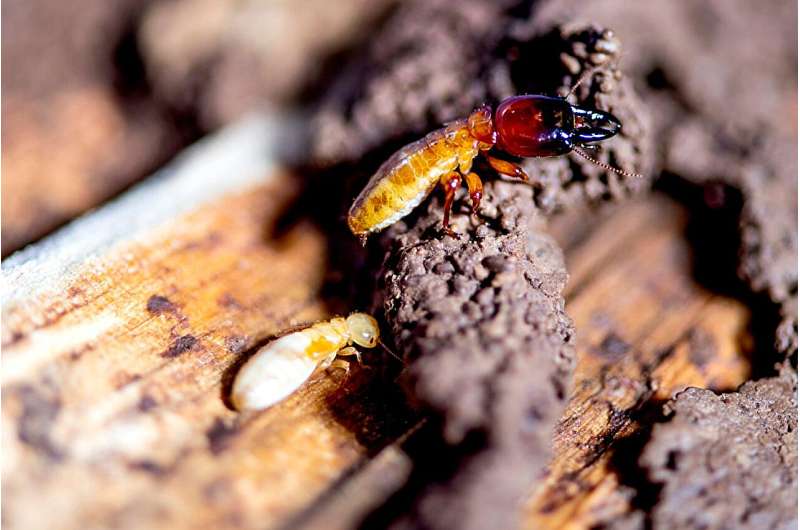This article has been reviewed according to Science X's editorial process and policies. Editors have highlighted the following attributes while ensuring the content's credibility:
fact-checked
trusted source
proofread
Being queen is all in this termite's head, finds gene expression study

In the world of termites studied by Northeastern professor Rebeca Rosengaus, worker termites spend their few short months on Earth cleaning and feeding their enormous long-lived queen mother and tending to her eggs and their young siblings.
Since termite workers and queens both possess a network of genes called the Queen Central Module (QCM), it has been a bit of a mystery why some termites assume sterile worker roles while a few go on to become reproductively active queens that mate with termite kings and live for years, Rosengaus says.
The answer appears to lie in where the expression of certain genes of the QCM takes place, according to a paper Rosengaus and collaborators published in the open access journal Scientific Reports.
In both worker and queen termites, the genetic expression takes place in the abdomen. But in termites destined to be queens, the gene expression also takes place in the thorax and head.
"It's not only the queens that have this queen central module network. Everyone has it. It's just being expressed in a different way," say Rosengaus, an associate professor at Northeastern's Department of Marine and Environmental Sciences who specializes in behavioral ecology and insect sociobiology.
"As the queens become queens, the genes of this network start being overly expressed. They start producing a lot more product than the product produced in the workers' heads."
In the past, scientists didn't see how the genetic expression changed in different parts of the insects' bodies because they ground up the whole body for transcriptomic molecular analysis, Rosengaus says.
"The neat part of this study here is that we divided the head and the thorax away from the abdomen of each individual we tested. That allowed us to see that the queens have a lot of upregulation of QCM in the head and the thorax, but not in their abdomen."
Most previous transcriptomic studies of caste differentiation in social insects have analyzed ants, bees and wasps, Rosengaus says.
The study, done in collaboration with Judith Korb at the University of Freiburg in Germany, analyzed the species Zootermopsis angusticollis, a species from a termite family called Archotermopsidae which evolved long ago.
A similar pattern of gene expression has also been observed in the species Cryptotermes secundus from an the family Kalotermitidae, which is an intermediate family in the termite phylogenetic tree.
Rosengaus, who collects termites feeding on redwood stumps and decaying logs in annual trips to California, says termites play an important role in ecology, breaking down the remains of dead trees while increasing the nitrogen content of the soil.
In more recently evolved termites species, the queens are particularly large relative to their workers. In such species, it may seem weird to have a queen that lives as long as 20 years while her sterile workers survive only a few months.
But in terms of growing the nest, "this strategy must be working well," Rosengaus says. "Otherwise, evolution would have likely supplanted this strategy with another innovation, another way of doing things."
More information: Silu Lin et al, A genetic toolkit underlying the queen phenotype in termites with totipotent workers, Scientific Reports (2024). DOI: 10.1038/s41598-024-51772-7
Provided by Northeastern University
This story is republished courtesy of Northeastern Global News news.northeastern.edu.


















